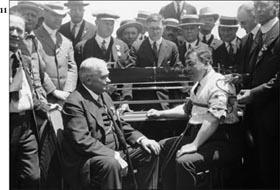The Lie Detectors (47 page)
Authors: Ken Alder

Royal Canadian Mounted Police Ruby, Jack
Rush Medical School, Chicago
Saint Valentine’s Day massacre
San Francisco Call and Post,
San Francisco earthquake
San Francisco Examiner,
Sanger, Margaret
Saturday Evening Post,
Scheffer v. United States
(1998)
Schick, George E.
Schindler, Raymond
Scientific evidence;
see also
Forensic sciences
Daubert v. Merrell
(1993)
expert witnesses
Frye ruling (1923)
juries, and
Wigmore’s views of
Scientific management
Scientology
Scopolamine (truth serum)
Scott, Orlando
Scott, Walter Dill
Sears, Roebuck
Self-inflicted pain
Selfridges, London
Sensation Comics,
Sensory deprivation
September 11,2001,
Shils, Edward
Show Boat
(movie)
Shuler, "Fighting Bob,"
Shultz, George
Simple Home, The
(C. Keeler)
Simpson, O. J.
Skilling, Jeffrey
Sleep deprivation
Sloan, Charles A.
Small, Len
Smith, Margaret Chase
Smithsonian Institution
Sodium amytal
Sodium nitrite
Spanish-American War
Spanish Inquisition
Stanford University
Starr, Ken
State, U.S. Department of
Stein, Gertrude
Stevens, Viola
Stevens, Walter
Stewart, James
Stimulation test.
See
Card test
Stock market crash of 1929
Stockton internment camp, California
Stoelting Company
Stonebarger, Harvey
Strange Woman
(Rodger)
Summers, Walter G.
"Sunny Side of the Atom, The" (CBS radio documentary)
"Superman,"
Supreme Court of the United States
Tachycardiogram
Tambours
Tattoos
Taylor, Margaret.
See
Larson, Margaret Taylor
Taylorism
Tennessee Maximum Security State Penitentiary
Terman, Lewis
Testing anxiety
Thayer, Charles
Third degree
Thomas, Clarence
Thought-Wave Detector
Thurstone, L. L.
Topeka State Journal,
Torment of Secrecy, The
(Shils)
Torrio, Johnny
Torture
and confessions
judicial torture
psychological torture
self-inflicted pain
sensory deprivation
sleep deprivation
third degree, the
U.N. Convention Against Torture(1984)
war on terror, and
water-boarding
Treatise on the Anglo-American System of Evidence
(Wigmore)
Trolle, Marie af (aka Marie Goodwill)
Trovillo, Paul
Truman, Harry
Trust
in marriage
in workplace.
Truth serum
Tufts University
Tycos Instruments
Ulpian
Underwood, John
Union of Mine Workers (UMW)
United Nations
U.S. Patent Office
U.S. Surgeon General’s office
U.S.S.
Pritchett,
Universal Pictures
University of California-Berkeley
University of California-Los Angeles
University of Chicago
University of Chicago Press
University of Iowa
Valier bombing
Van Pelt, Clayton F.
Vernon, Bert T.,
Vietnam War
Vollmer, August
in Chicago
education of
health of
innovations of
Keeler and
Larson and
Larson-Keeler collaboration and
as Los Angeles chief of police
marriage of
sex scandal surrounding
suicide of
Wickersham Commission and
Vollmer, Millicent "Pat" Gardner
Walgreens
Walter, Herbert J.
Walush, Vera
War on terror
Warren, Earl
Warren Commission
Warren Supreme Court
Washington, George
Washington Confidential,
Washington Post,
Waterbury, Frank
Watergate
Watson, John B.
Wertham, Frederic
Western Electro-Mechanical Corporation
Whale, James
Wherry, Kenneth
Whitehead, Alfred
Wichita, Kansas
Wickersham Commission (National Commission on Law Observance and Enforcement)
Wigmore, John Henry
Wilkens, Henry
Williams, Alexander
Wilson, Charlie
Wilson, Jane
Wilson, O. W.
Windsor, Duke of
Wobblies
Women’s Air Force Service Pilots
"Wonder Woman" (Marston)
Word-association test
World War I
World War II
Wylie, Philip
Yale University
Yerkes, Robert Mearns
Yucca Flats, Nevada
Zubaydah, Abu
1. Courtesy Bill Larson;
2. Courtesy of Texas Woman’s University, The Woman’s Collection;
3. Courtesy of The Bancroft Library, University of California, Berkeley;
4. Jaquet Apparatus, Catalogue, 1073, late nineteenth century, from The Virtual Laboratory, http://vlp.mpiwg-berlin.mpg.de, Max Planck Institute for the History of Science, Berlin;
5. Münsterberg lab in 1893, courtesy Harvard University Archives;
6. Marston/Lampe family;
7. Bettmann/CORBIS;
8. Courtesy of the Berkeley Police Department Historical Unit;
9.
San Francisco Examiner
, August 9, 1922;
10.
San Francisco Call and Post
, August 17, 1921;
11. Bettmann/CORBIS;
12. Courtesy of The Bancroft Library, University of California, Berkeley;
13.
Newsweek
, March 13, 1937, p. 34;
14. Courtesy of The Bancroft Library, University of California, Berkeley;
15. Bettmann/CORBIS;
16. Tribune Media Services, Inc. All Rights Reserved. Reprinted with permission;
17. Tribune Media Services, Inc. All Rights Reserved. Reprinted with permission;
18. E. Keeler,
Lie Detector Man
, 144;
19. Applegate family;
20. John Larson,
Lying
, figs. 47, 48;
21. Christian A. Ruckmick,
The Psychology of Feeling and Emotion
(New York: McGraw-Hill,1936), 287;
22. Marston/Lampe family;
23. Marston/Lampe family;
24. News clipping, unknown source, dated August 11, 1929;
25.
Life
magazine, December 19, 1938; permission Proctor & Gamble;
26.
Look
magazine, December 6, 1938, pp. 16–17;
27. Charles Moulton [William Marston], "Wonder Woman Versus the Prison Spy Ring,"
Wonder Woman
, No. 1 (Summer 1942);
28. Alva Johnston, "The Magic Lie Detector,"
Saturday Evening Post
, April 15, 1944, p. 9;
29.
Chicago Herald American
, February 7, 1948, p. 15;
30.
Liberty
magazine, June 21, 1947, p. 15;
31. CORBIS;
32. The Herb Block Foundation, 1954;
33. Hulton-Deutsch Collection/CORBIS
Ken Alder is Professor of History and Milton H. Wilson Professor in the Humanities at Northwestern University, where he directs the Science in Human Culture Program. He lives in Evanston, Illinois.
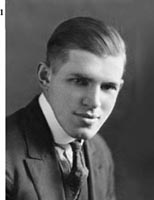
John Larson (1892–1965), the nation’s first cop with a Ph.D. in science, assembled the first working "lie detector" under the auspices of August Vollmer, chief of police of Berkeley, California. This photograph, dated April 24, 1921, shows Larson two days after his first case, the College Hall theft, transformed his life.
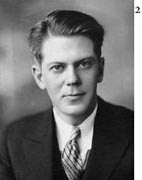
Leonarde Keeler (1903–1949) was named after Leonardo da Vinci, but preferred to be known as "Nard." He was a Berkeley high-school student and amateur magician when he became entranced by Larson’s machine. His patented "Keeler Polygraph" made him the personification of American lie detection.
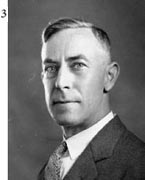
August Vollmer (1876–1955), chief of the Berkeley police department from 1906 to 1932, was the celebrated father of American professional policing. Vollmer saw in Larson and Keeler’s lie detector a means to replace brutal "third degree" interrogations with more scientific and lawful techniques.
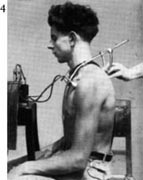
In the second half of the nineteenth century, European scientists like Étienne-Jules Marey recorded the bodily responses of subjects in order to track hidden mental processes, such as stress and fear.
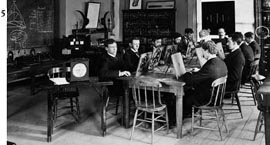
At the turn of the twentieth century, Hugo Münsterberg (1863–1916) established a psychology laboratory at Harvard where students transformed their inner lives into the public phenomena we call science. With his techniques, Münsterberg (seated at the head of the table) claimed he could discern when a subject was suppressing the truth.
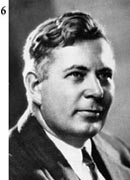
By tracking his fellow students’ blood pressure during role-playing games, William Moulton Marston (1893–1947), one of Münsterberg’s disciples, claimed he could sort truth-tellers from liars nearly 100 percent of the time. Marston earned a law degree from Harvard and a Ph.D. in psychology.
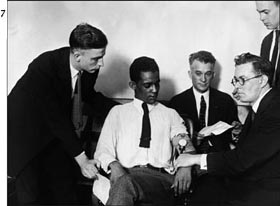
In 1922 a trial judge refused to let Marston (seated at right) testify that his test had exonerated James Alphonso Frye (center), who had retracted a confession of murder. Following this precedent, lie detector evidence has been largely excluded from criminal trials to the present day, although its use has been allowed in criminal investigations and many other settings.
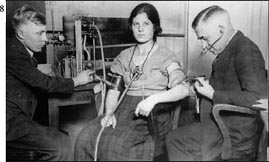
On hearing of Marston’s early experiments, Larson rigged a device to continuously record the blood pressure and breathing depth of subjects while they answered "Yes" or "No" to alternating relevant and irrelevant questions. In 1921, Larson found the ideal experimental setup to prove his technique: a theft at an all-woman’s college residence, the College Hall case. Here Larson (left) and Vollmer test a Berkeley undergraduate.
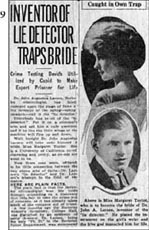
Larson used the crime victim, Berkeley freshman Margaret Taylor, as his "control" in the College Hall case. The case appeared solved when one of her dorm sisters reacted furiously to being questioned on the machine and subsequently confessed. Over the next few months, Larson invited Miss Taylor back to interrogate her about her feelings for him—in the interests of objective science, of course. A year later, on August 9, 1922, their nuptials were front-page news in the
San Francisco Examiner.
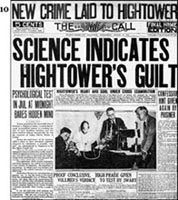
This
San Francisco Call and Post
exclusive of August 17, 1921 conferred national fame on the "lie detector," as the press now christened the device. Soon after the device spoke from the front page of the newspaper, a jury convicted Hightower of murdering a local priest.
